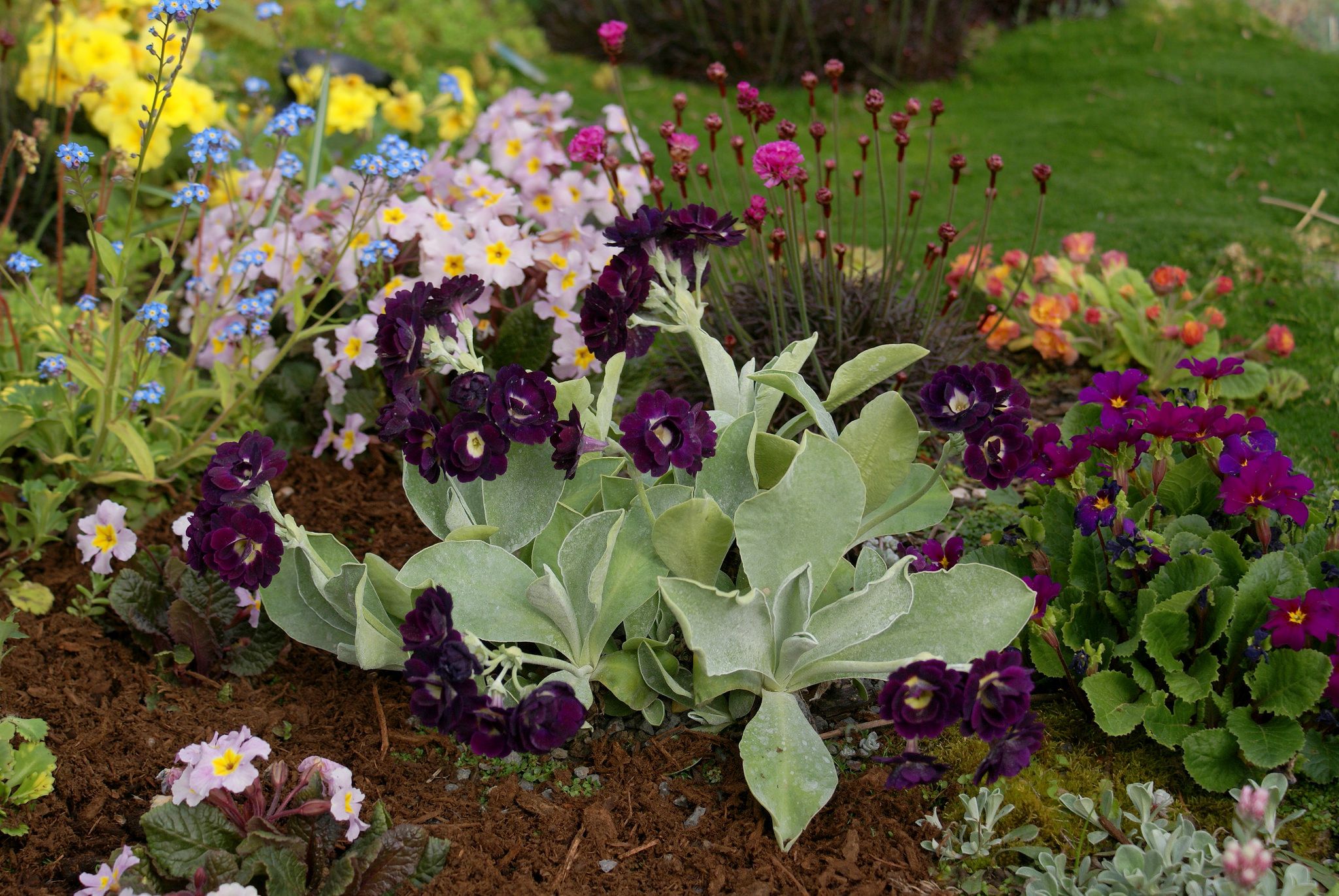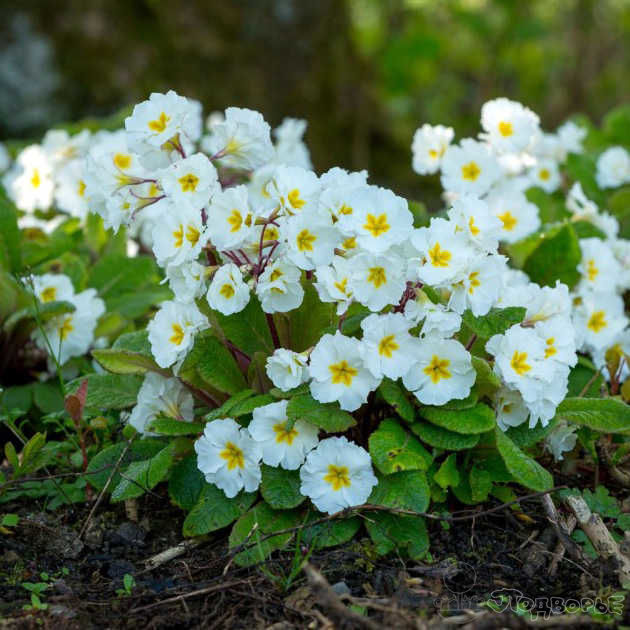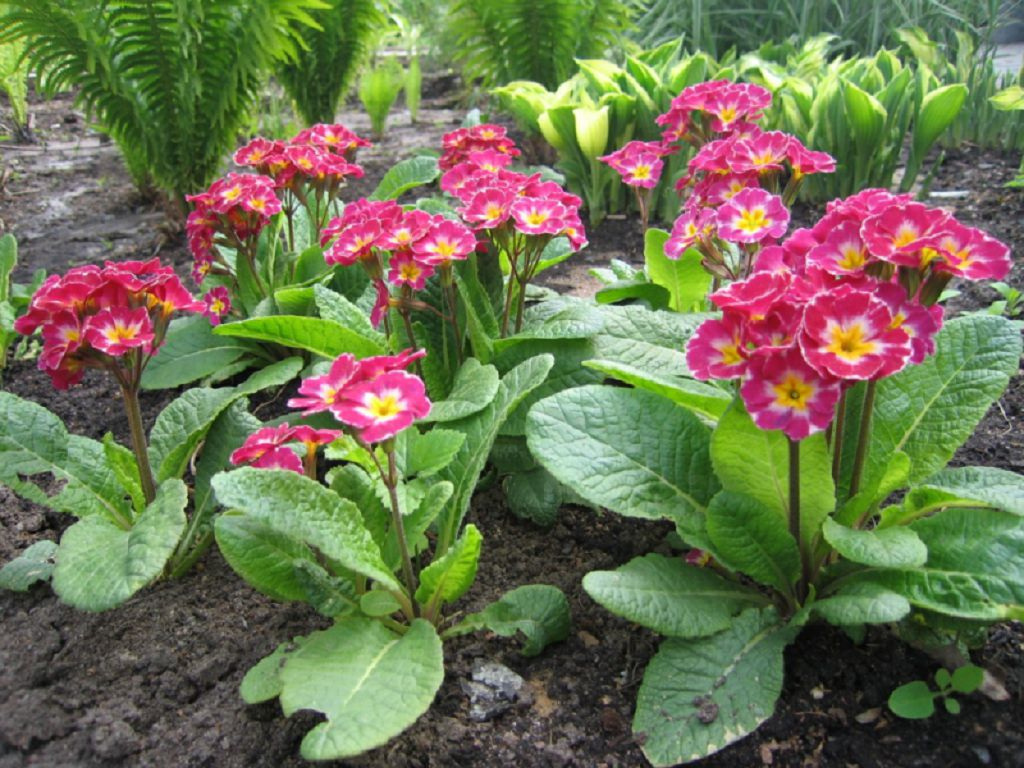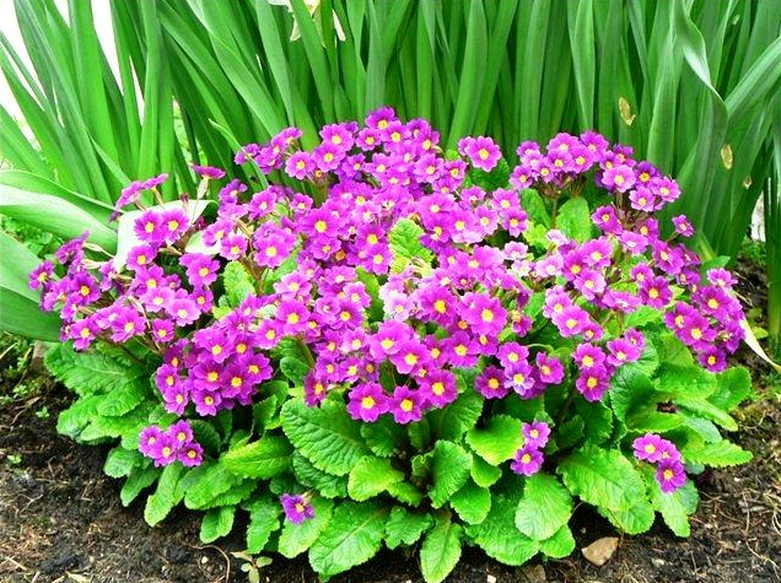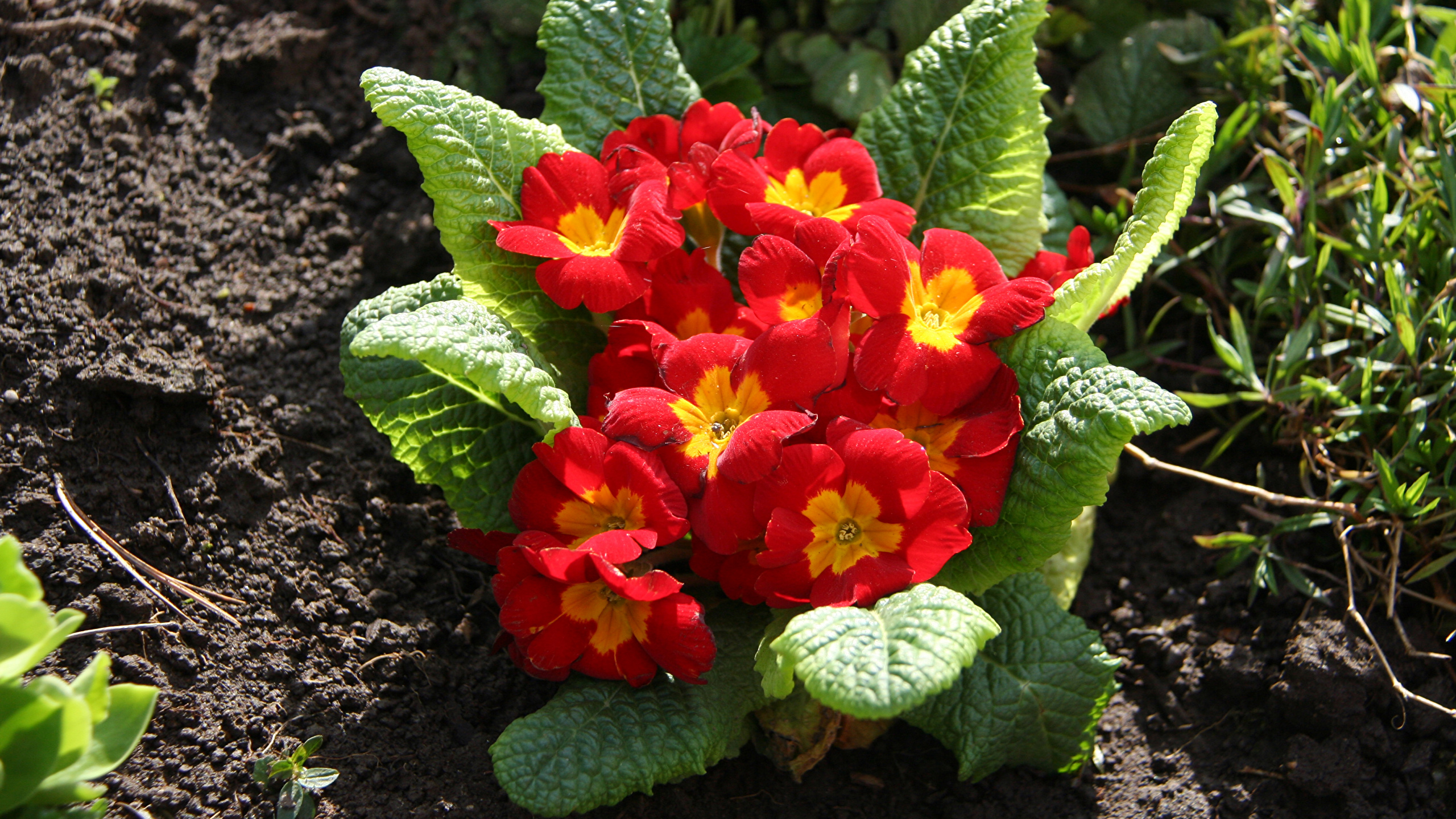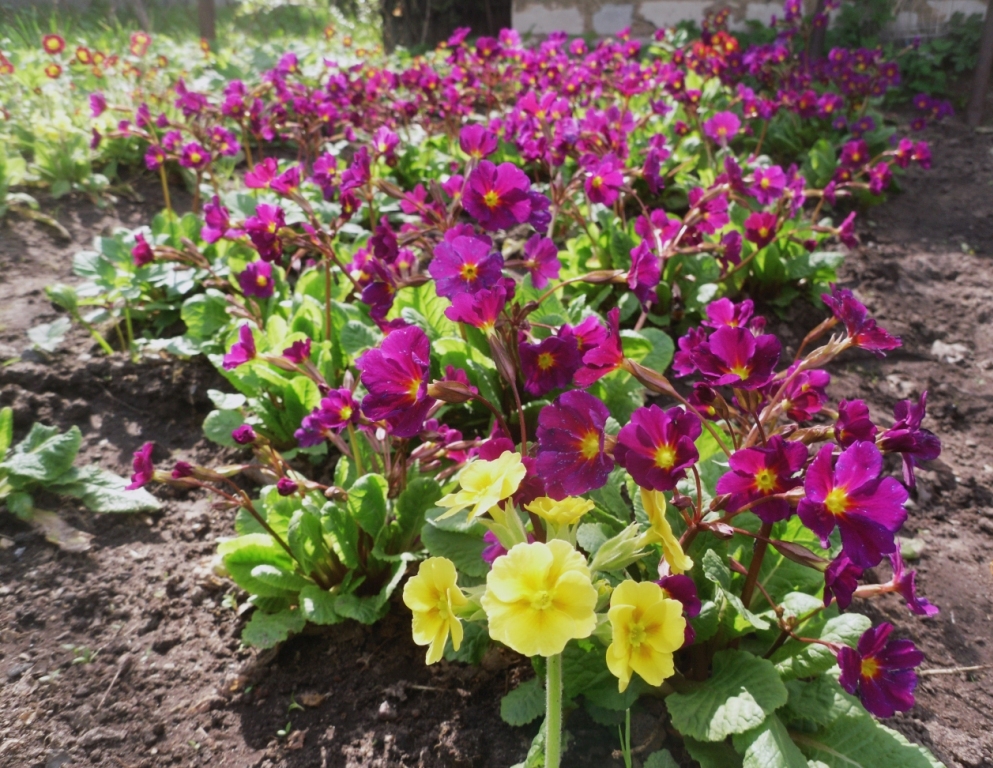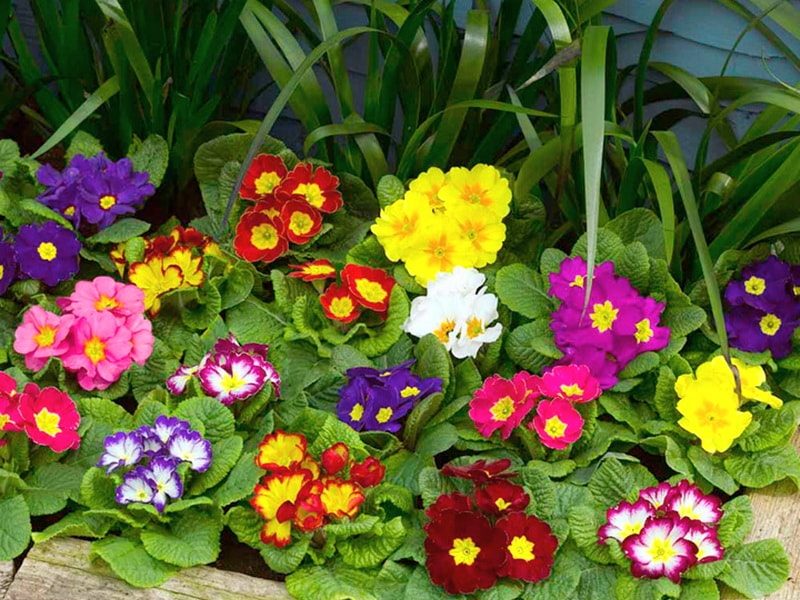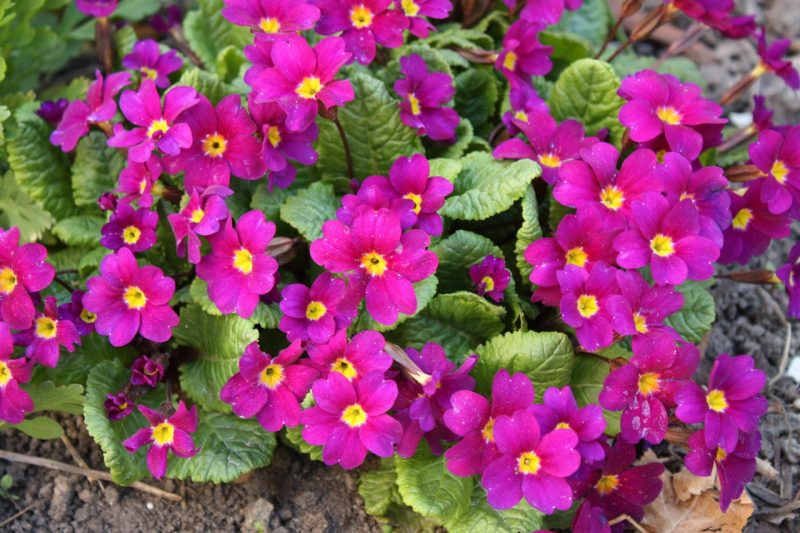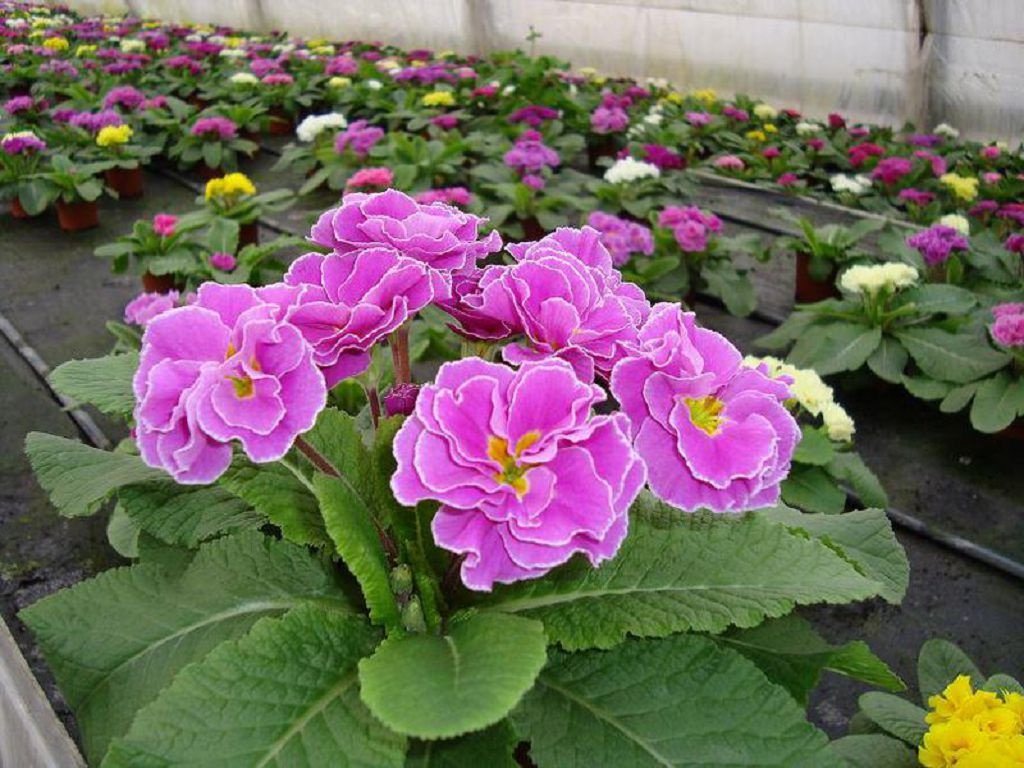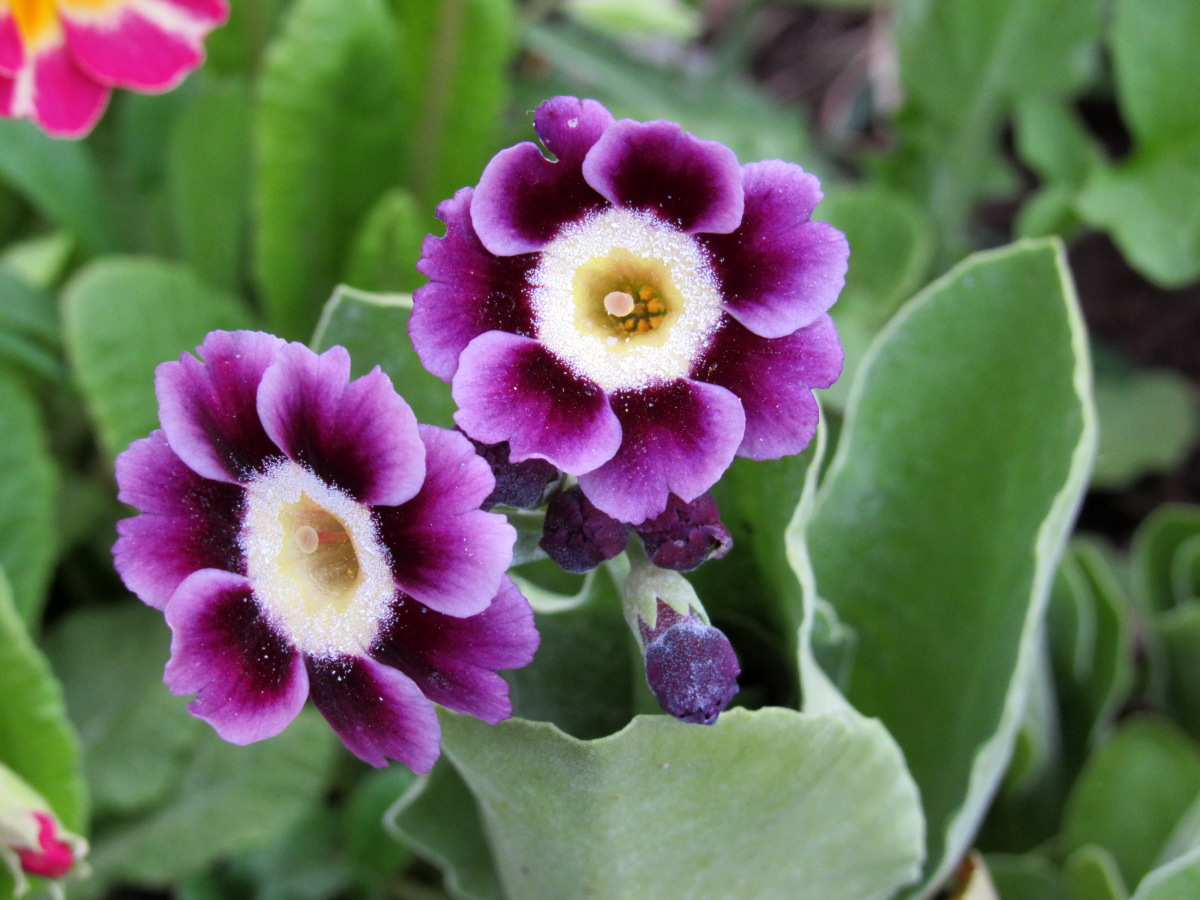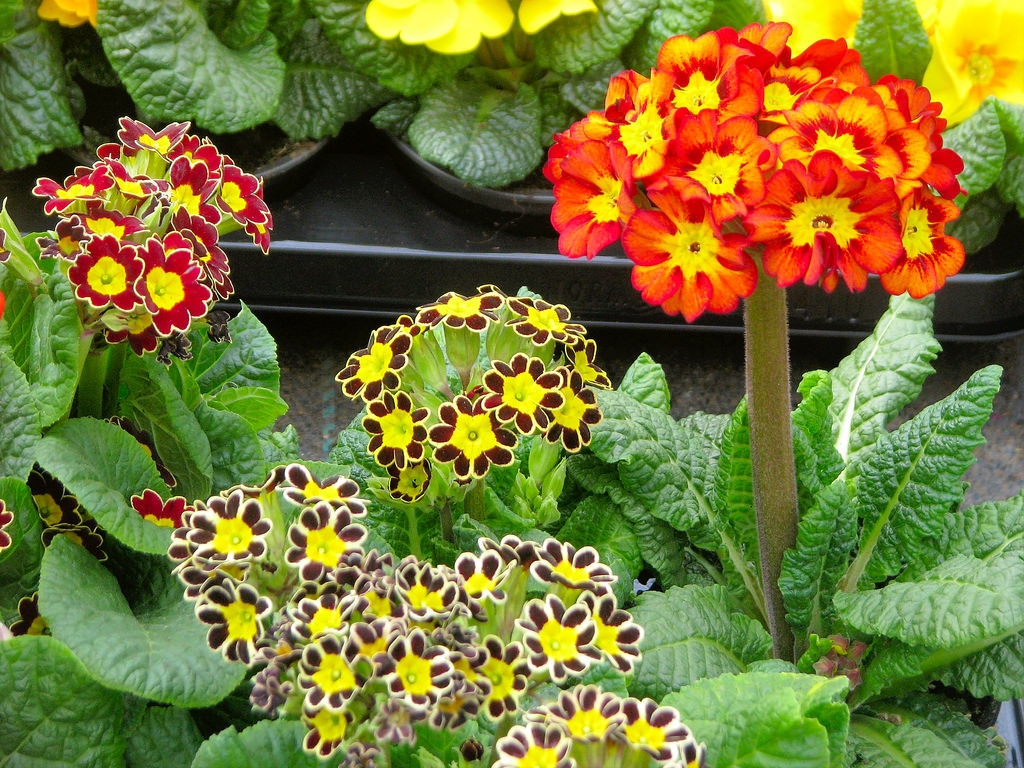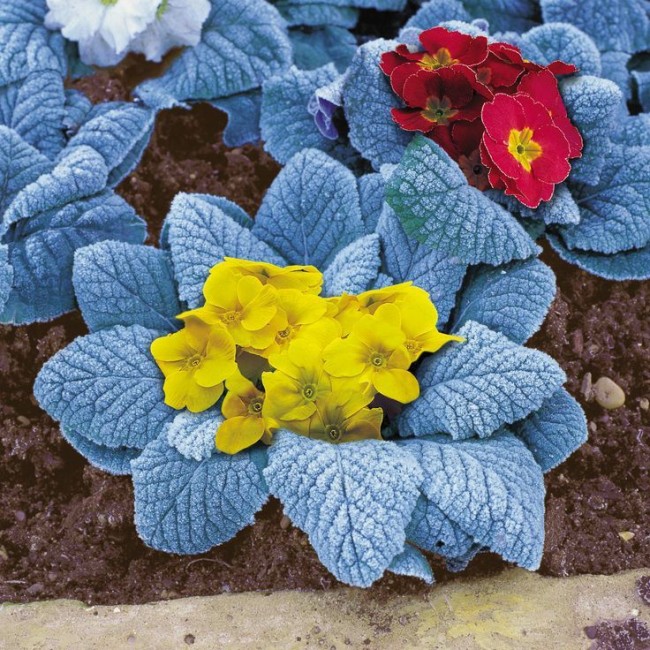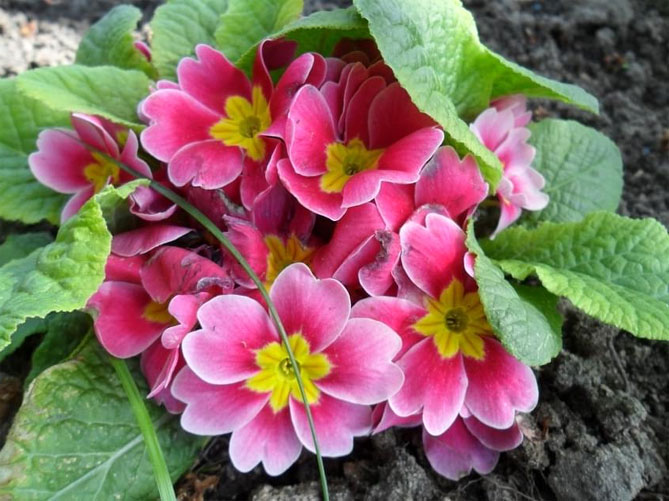Names of primroses, fine-toothed primrose and other species
The wide variety of primroses has made it difficult to classify them. To make it easier for gardeners to distinguish between representatives of the genus, they were grouped according to the types of inflorescences: umbrella, cushion, capitate or spherical, tiered or candelabra, bell-shaped. Let's list the names and give a description of the most popular primroses.

A compact hybrid (5-20 cm) of the perennial garden primrose shown in the photo is successfully grown both indoors and outdoors.
Ellipsoid, elongated leaves on long petioles have a bright green color. Flowers appear on strong, thin and tall peduncles in April-July. Various shades:
The fine-toothed primrose attracts attention with its dense ball-shaped inflorescences (up to 10 cm in diameter), which are crowned with tall and strong peduncles up to 60 cm in height (without them, the plant rises by 30 cm and has the same width).
Small flowers (up to 1.5 cm) are red, white, purple with varying degrees of color intensity. Leaves are oval-oblong, wrinkled, serrated (thanks to them it got its name)
It blooms for 30-40 days in April-May. Characterized by cold resistance and unpretentious care.
Obkonika primrose (reverse conical) is very popular. Its size can reach 60 cm. The leaves are pubescent, rounded, wavy at the edge. Fragrant flowers appear in a group on numerous peduncles and form a kind of cap, the color of which can be different depending on the variety. It blooms in winter and spring, but it is capable of all year round. May cause allergies.
Viala primrose (orchid) is extravagant. Its candelabra inflorescences 5-7 cm long and openwork dark green foliage will wonderfully decorate rockeries, rocky areas and alpine hills. The leaves are unevenly serrated along the edge, with sparse hairs on both sides.
The inflorescence on a flower arrow, 15-20 cm high, is covered with rich red buds. Then the fragrant bell buds open (up to 1.3 cm) and show their lilac-lavender content. This process occurs gradually, from the bottom of the inflorescence to the crown. Flowering can be observed in June-July.
Primula Julia grows compactly, not exceeding 10 cm in height. Leaves are rounded-oval or oval on pterygoid petioles, dentate, light green. Single flowers no more than 3 cm in size mauve in color with a yellow spot in the middle appear in late April-mid-May. Great for alpine slides, as it forms solid rugs during flowering.
The Japanese primrose is unique in the arrangement of flowers (about 2 cm in size) on high (up to 30 cm) whorled peduncles. They are distributed evenly in 5-6 tiers. Blooms for about a month (June-July). The foliage is bright green, serrated.
Terry hybrids have been obtained as a result of the selection of several species. Such primroses are not found in nature. Due to their increased decorativeness, they are in special demand. The colors are different, sometimes very unusual. The caps of flowers of double varieties reach a diameter of 10-15 cm, and the flowers themselves are 4-5 cm. Plants are rather compact. They bloom for 2-3 months (from April to June), and can be repeated - in September-October.
Useful properties and contraindications
The plant contains highly concentrated manganese salts. The aerial part contains many vitamins, while the rhizome contains essential oils, saponins and glycosides. In spring, leaves accumulate carotene and ascorbic acid. Therefore, salads and soups are prepared from them.The roots and leaves are dried, powder, decoctions and infusions are made from them.
An infusion of leaves helps out in the treatment of bronchitis, tonsillitis, neuroses, pain in the head, as well as sleep disorders. Infusion from the roots helps to dissolve external hemorrhages, is used in the form of compresses, lotions and wraps for bruises and skin diseases.
There are contraindications to the use of preparations containing primrose:
- any stage of pregnancy, primrose can cause uterine contractions and miscarriage;
- ulcer, stomach upset;
- allergic reaction;
- individual intolerance to plant components.
It will also be interesting: Clivia - home care, types and growing of a flower?
Flower varieties
Despite the many species of perennial plant, only a few have gained popularity in horticulture. This is due to their unpretentiousness to growing conditions and spectacular appearance.
Ordinary
Another name for this primrose is stemless, it is considered one of the most popular among flower growers. Its height does not exceed 20 cm, and the flowering period begins in April. Leaf plates are deep green, have a corrugation on top and an oval shape. The color of the flowers is different - from white to purple, their diameter ranges from 2 to 4 cm.
Advantages and disadvantages
Unpretentiousness to the composition of the soil.
Compact dimensions.
Rich color palette.
Early flowering time.
The need to grow in partial shade, bright sun rays spoil the color of the petals.
Demanding watering.
I like not like
Haller's Primrose
The mountain slopes of the Carpathians and the Alps are considered the birthplace of Haller's primrose. There, the primrose chooses sunny areas with calcareous soil. The height of the plant is from 10 to 30 cm, and the color of the petals is light purple. The first flowers delight with their appearance, starting from the last days of April.
Advantages and disadvantages
Attractive appearance.
Ease of reproduction.
Early flowering time.
Poor seed germination in the second year after harvest.
Demanding open sunny areas.
I like not like
Spring
Spring primrose, or medicinal, is characterized by sweet-smelling flowers of bright yellow color and low height. The buds are collected in umbellate inflorescences up to 15 cm in diameter.
Advantages and disadvantages
Undemanding to the place of cultivation.
Pleasant aroma that primrose exudes during the flowering period.
The ability to use as a medicinal plant.
The only bud shade in this group.
Short flowering period.
I like not like
Auriculate
This type of primrose belongs to evergreens. The species itself has only one color - yellow, but the hybrids are red, white and green. The height of the peduncles is up to 25 cm, the buds are collected in umbrella inflorescences.
Advantages and disadvantages
Decorative view of primroses.
Undemanding to the composition of the soil.
Early flowering time.
The need for frequent watering.
Low seed germination in the second year after collection.
I like not like
Small
The smallest of the primroses, the homeland of which is the Balkans and the Carpathians. The diameter of pink-red flowers does not exceed 3 cm, in appearance they resemble small stars. The flowering period begins in mid-May.
Advantages and disadvantages
Compact dimensions.
Shade tolerance.
Average winter hardiness.
Decorative type of buds.
Short flowering period.
Demanding soil moisture.
I like not like
Mealy
Representatives of this species are the most short-lived, usually they are grown for 2 years, then the planting needs to be updated. The color palette ranges from white to reddish purple.
Advantages and disadvantages
Many varieties with different shades of petals.
Undemanding to the place of cultivation.
High decorative qualities.
Ease of seed propagation.
Short flowering period.
Impossibility of growing for more than 2 years.
I like not like
High
One of the tallest primrose species - it grows up to 40 cm. The flowering period begins in April and lasts up to 45 days.
Advantages and disadvantages
High decorative qualities of leaves and flowers.
Simplicity of vegetative and seed reproduction.
High winter hardiness.
Long flowering period.
Demanding on light soils.
The need to use fresh seeds for propagation.
I like not like
Reverse conical
This species of primrose has some of the largest flowers - up to 6 cm in diameter.
Advantages and disadvantages
Ease of reproduction.
Undemanding care.
The plant has a short life span of 2 years.
The need for regular hydration.
I like not like
Malvopodobny
This type of primrose is highly regarded among gardeners for its decorative qualities. The flower grows to a height of 30 cm and is characterized by an abundance of buds.
Advantages and disadvantages
A wide range of petal colors.
Early flowering dates for autumn planting.
Low seed germination in the second year after collection.
Requirements for the irrigation regime.
I like not like
Japanese
One of the latest flowering species. The diameter of the buds is up to 2 cm, they are located on strong peduncles.
Advantages and disadvantages
Easy to care for.
Several breeding methods.
Demanding coverage of the site.
The need for regular watering and feeding.
I like not like
Planting garden primroses
This culture is propagated by seeds, cuttings, dividing the bush. Well, you can also buy ready-made seedlings in the store. Yes, it is expensive (if you plan to plant an entire flower bed or rabatka), but you will get the result as quickly as possible.
Seed sowing
This is the most convenient and common way to reproduce these colors.
Everything is done like this:
- A shallow box with drainage holes is filled with earth (universal soil rich in peat, turf, vermiculite, but especially sand). The bottom of the box can be lined with foil, but be sure to make a couple of holes in it to drain the water. The soil is watered a day before sowing.
- Primrose is sown from February to March.
- The seeds are not sprinkled with earth, only slightly pressed and gently sprayed from a spray bottle. Distance: 1 cm between large seeds or 5 small seeds per 1 cm.
- Many older varieties need stratification after sowing (2 to 4 weeks in the snow or refrigerator). New breeding varieties do without this procedure.
- Germinate them under glass or film, in the light, at 15-18 degrees, watering with the lower method. Do not allow condensation to accumulate on the film!
- Did you see 2 real leaves? Dive!
- Feed the seedlings with mineral water (a weak fertilizer solution) three times a month.
You can see with your own eyes the stratification of the seeds of this culture and hear a lot of sensible comments from an experienced gardener in this video:
Transfer to open ground and care
Depending on the variety, the seedlings should be 10-20 cm tall. Most of the plants are released in May.
The site should be wet, but well-drained, in partial shade. It is desirable that the soil is nutritious (before planting, you can dig up a flowerbed with compost, and if the soil is clay, add vermiculite or sand as well).
- Distance between bushes: 10 to 70 cm.
- Landing method: transshipment.
- Root collar: deepens.
Immediately after planting, the flower bed is watered (but do not get water on the leaves). In the first 2-3 nights, you can wrap the primroses with foil.
You need to water the primroses often so that the soil does not dry out. It is also advisable to mulch the flower bed.
You can feed the flowers with mineral fertilizer, superphosphate, manure infusion (not fresh).
For the winter, most varieties do not hide, but do not cut off the leaves - they will protect the root from frost.

Perennial garden primrose care
When caring for a plant, the following rules must be observed:
- For the winter, the primrose is covered with a layer of dry foliage (10 cm).
- Compliance with the water regime is a very important aspect. It is necessary to constantly maintain the moisture content of the soil, especially in spring, but at the same time, stagnation of water and moisture on the leaves should not be allowed.
- Top dressing. During the growing season, the plant needs additional nutrition. Ordinary manure is perfect for this.
- Root system protection. The rhizome of the plant, growing, is gradually exposed. To protect it from freezing in the winter and from drying out in the heat, it is necessary to sprinkle earth on the bushes in the fall.
- Timely weeding. This will save the primrose from downy mildew and gray mold damage. Damaged specimens should be treated with an appropriate preparation, severely affected ones should be removed.
Primrose in landscape design
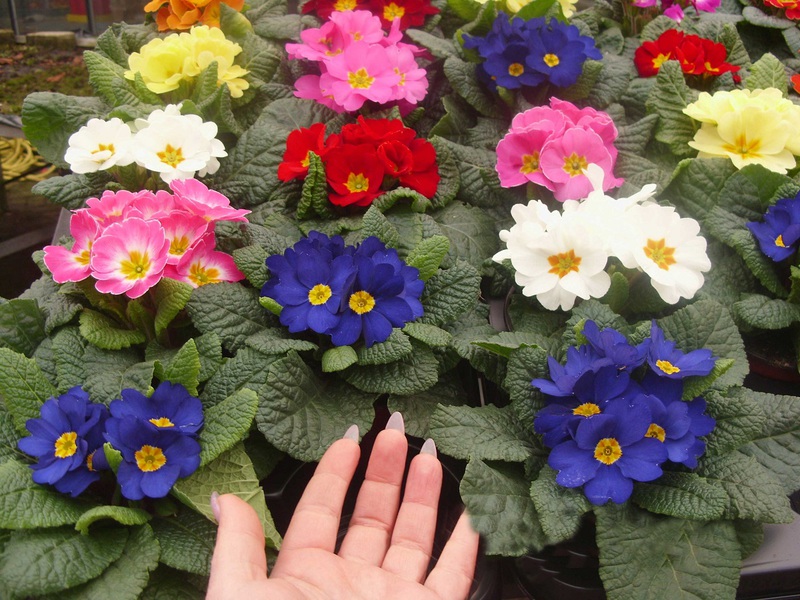


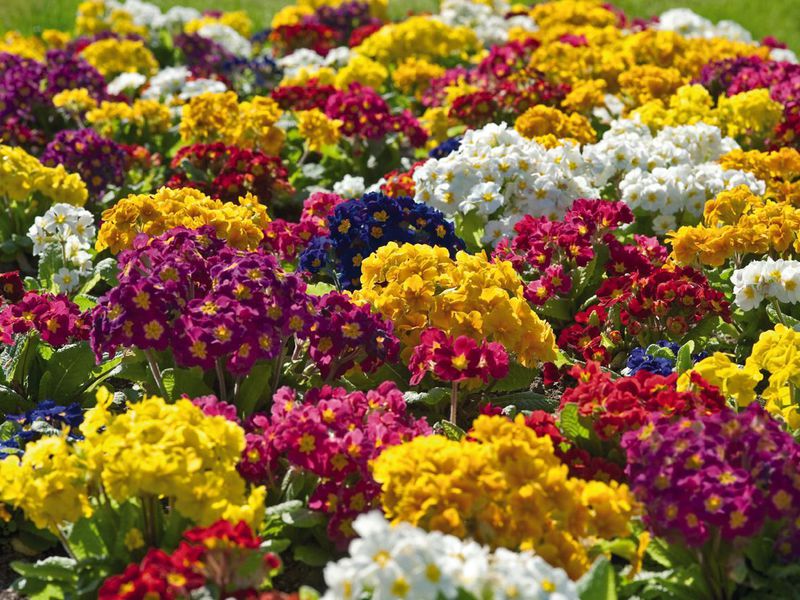

The garden primrose is distinguished by a variety of species. And with a successful combination of different varieties, you will get a magnificent garden blooming from April to August. The plant looks great in a rabatka, it can be used to decorate rocky hills and corners, as well as plant colorful bushes on the lawn.
Small artificial reservoirs look gorgeous, near which fragrant Alpine and Sikkim primroses grow. Garden paths, along which a collection of brightly colored plants is placed, will give the plot an unusual flavor.
Tulips, low irises, muscari, thorn-shaped phlox, daffodils and soapwort are suitable as primrose "neighbors". Often, primroses are planted in garden containers and flowerpots to decorate the surrounding area and the house.
Landing options
 First option. The primrose will look good among the sparsely planted peonies, which will pick up the flowering baton from the primrose and hide its unattractive dried foliage.
First option. The primrose will look good among the sparsely planted peonies, which will pick up the flowering baton from the primrose and hide its unattractive dried foliage.
Second option. Primroses do well (especially with abundant moisture during dry periods) next to the snapdragon on the northern side of the alpine hill, where direct sun is only at noon.
The third option. A large amount of snow accumulated over the winter near clematis will "please" primrose very much in the spring, so both of these plants complement each other well.
Fourth option. Just next to the sorrel, in the garden, in a bunch.
So that after all the work in planting and caring for the primrose you will not be disappointed, try to first study all the features of a particular species, since the requirements for different varieties may differ significantly.
How to care for primrose at home
Primrose breeding is not as difficult as it might seem at first glance. After reading the basic recommendations of experts on creating optimal conditions for a flower, you can grow a healthy plant and even propagate it.
Lighting
Perennial primrose is distinguished by a wide variety of varieties, which allows you to get aesthetic pleasure from the contemplation of beautiful flowers during the entire spring-autumn period. Almost all varieties suitable for growing in garden conditions are unpretentious, so a part of the garden where other plants do not want to grow may be suitable for primrose. When caring for a primrose, it should be remembered that this flower prefers diffused lighting, direct sunlight is harmful to it. Planting a plant requires adherence to a number of simple rules. Primrose varieties that prefer direct sunlight are very few in number, so when choosing a place to grow these bright flowers, you should focus on shaded areas and partial shade flower beds.

Primroses are unpretentious in care, but it is preferable to choose places with diffused lighting for them.
Temperature
In summer, the plant is best kept on an open balcony or garden. After the end of the flowering season and with the onset of cold weather, the home primrose becomes a full-fledged indoor flower.Primrose is great for outdoor cultivation as it prefers cool temperatures. For example, it is better to keep house flowers at 16-20 ° C, and during flowering they are recommended to be transferred to the northern windowsill. Naturally, the plant will grow well at normal room temperature, but in this case, you should not hope for long flowering. Sometimes, primrose pots are even placed between the frames of old windows to ensure optimal conditions for it.
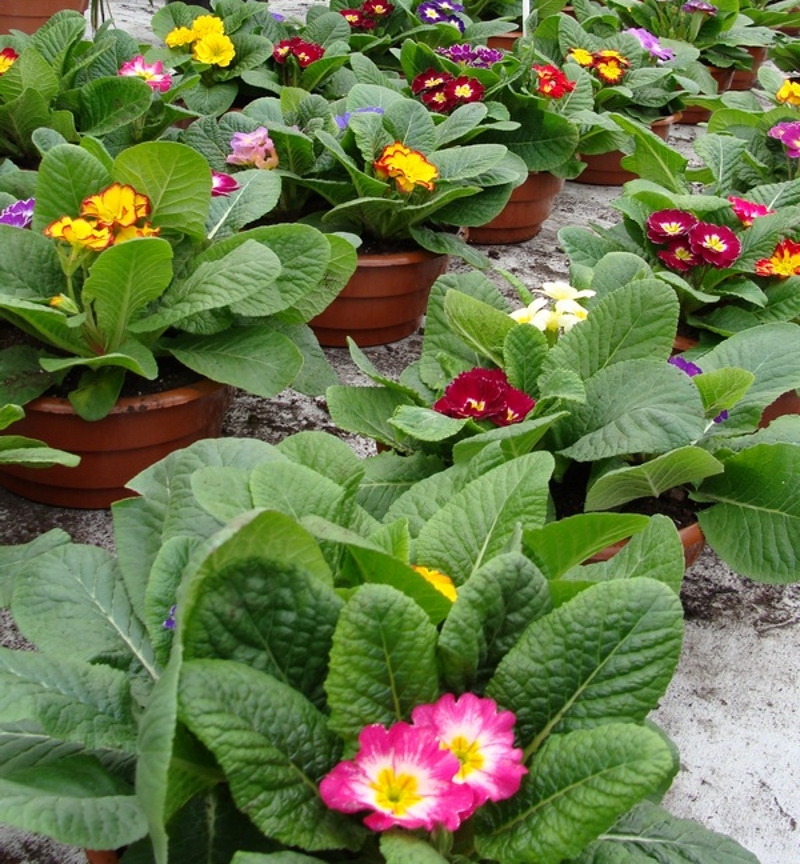
In the summer, indoor primroses are best taken out into the open air.
Humidity
The flower signals a lack of moisture by drying out the edges of the leaves. The atmosphere around the primrose should be humid, from time to time the leaves should be sprayed with warm and soft water.

Primrose - moisture-loving flowers
How to water primrose
During the dormant period, when the flower does not bloom, it is watered moderately, avoiding excess moisture that can destroy the primrose roots. During flowering, primrose requires abundant watering, so as soon as the soil on the surface of the flowerpot begins to dry out, moisten it with settled warm water. Watering should be carried out directly under the root, otherwise the delicate leaves may rot.
Top dressing
Home care implies the obligatory feeding of the plant. Most flower growers do not recommend feeding the plant with too rich fertilizer, it is better to dilute it strongly. It is preferable to apply the top dressing itself in a complex manner, starting from the moment the buds appear. It is not worth fertilizing the plant until the first signs of flowering, since it will refuse to bloom and will give all its strength to the leaf. During the period of active flowering, primrose should be fed every 14 days.
Bloom
As already noted, during flowering, primroses require a cool temperature, high air humidity and abundant watering. Also, do not forget about top dressing, which will help somewhat prolong flowering and give the plant the necessary components for the formation of colorful buds.

Flowering calendar of primroses
How to speed up the flowering of primrose
To accelerate flowering and stimulate plant growth, it is sprayed with special agents. A 0.01% gibberellin solution is perfect. Such preparations should be used at the stage when the buds are just beginning to form on the primrose.

You can speed up the flowering of primroses using 0.01% gibberellin solution
Primrose care after flowering
After the flowering period, the plant should be cut off, the faded buds should be removed from the bush and the primrose should be prepared for wintering. It is recommended to reduce watering and moistening; feeding should be carried out no more than once a month.
How to care?
Watering
Care is not particularly difficult when growing primrose. Systematic irrigation is required for it in the same way as systematic loosening of the soil and prompt disposal of weeds. So that water and nutrients are not wasted, faded flower stalks must be removed. Since primrose grows mainly in shaded areas, it should be watered without being overly enthusiastic. The only exceptions are especially hot days.
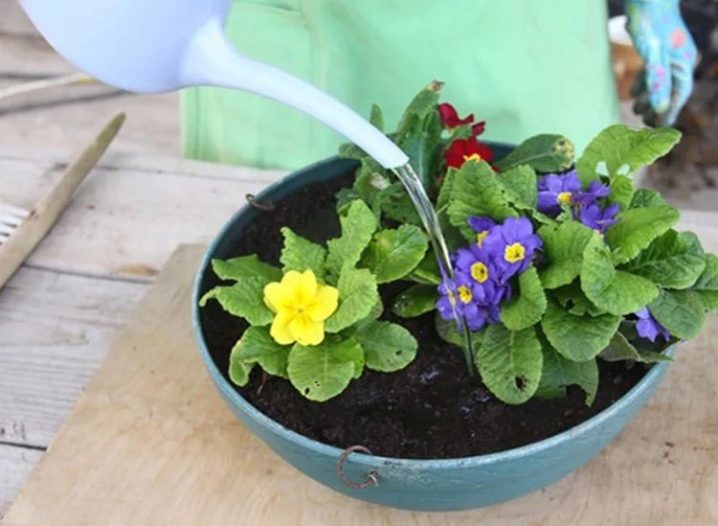
Top dressing
To grow a primrose, you still have to take care of fertilizing it. When the time for flowering comes, but the buds have not yet opened, a solution of a complex composition at a concentration of 1% is used. But you can't rush to use such a mixture. If you apply it when the buds have not yet appeared, all the beneficial effect will go to the leaves.
Primrose can be fed not only with mineral, but also organic fertilizers. When the flowering ends, a mineral composition dissolved in water is used.
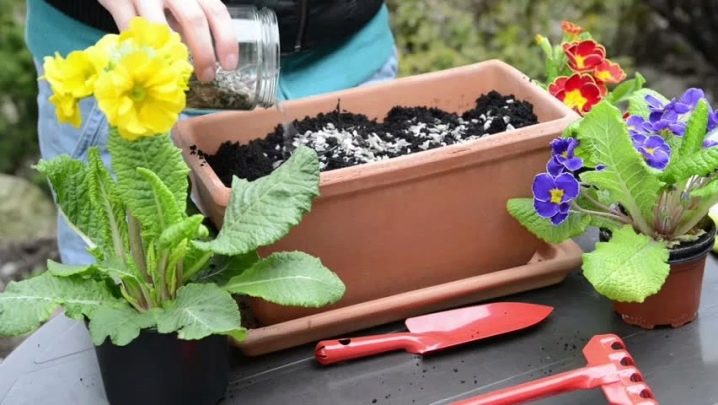
Perennial primrose: planting and care, photos of plants
Primroses, woken up in spring, need feeding and loosening. Therefore, we slightly rake off the loose shelter, apply complex fertilizer. If the primrose is early flowering, you can add only one potash or infusion of ash. If you overdo it with nitrogen, the power will go to the growth of the leaves.Next, we fertilize once every two weeks until the end of flowering. After flowering, we feed with a complex composition or phosphorus: once in summer, another in autumn. Summer feeding can be skipped.
Primrose photo:

Leaves left over from the fall are gradually removed when new ones appear.
Cut off the faded buds to prolong flowering.
Watering is plentiful - perennial primroses in the open air like to drink water, they will not even give up sprinkling, but only in warm weather.
After flowering, watering is reduced, if the summer is rainy, you can not water at all.
Closer to autumn, we are preparing the ground for planting new primroses, bought, donated. obtained from self-grown bushes.
We choose a penumbra for planting, closed from the winds, without stagnant moisture. I have
little keys grow under a large Antonov tree and under a chubushnik.
The soil should be loose, because the root system of the primrose is shallow and weak. The land is prepared in advance, about a month before planting. If there is a lot of clay. add humus and sand. Rotted manure will not hurt.
Periodically gently loosen the soil around the bushes for air to enter, or
mulch it. Weeding the weeds
With the growth of a perennial, the root system can become bare, by the fall we add humus and other soil to it. Then the cycle of development described above will be repeated.

When can you transplant perennial primrose outdoors
Usually, after three to four bushes grow, the inflorescences become smaller and they become smaller; if we see the need to separate the primrose and transplant, we produce it in August, even for early flowering ones, this can be done at the beginning of the month. only you need to cover for some time after such a landing from the open sun, of course. water for successful engraftment. In the year of such a transplant, I do not feed the keys with anything.
Perennial garden primrose: planting and care
Planting site for perennial primrose
This primrose prefers partial shade, although it can grow in the sun, but we must remember that in open places, delicate leaves are burned in it.
There are different varieties of early flowering and later primroses, but as a rule, flowering occurs in the month of May, when the sun is already “beating down” enough.
The best planting option is the trunks of trees and shrubs. For several years, primrose forms a flower meadow.
It can be planted somewhere in a secluded corner even in the shade of the building, the flowers will have enough moisture and lighting, and in the summer it has a dormant period.
And if your variety blooms twice, then in the fall, when all the plants have already faded, the primrose wakes up - and again pleases us with its variegated color.
Prefers primrose light, crumbly soils, does not grow on heavy loamy soils.
Reproduction of perennial primrose
Garden primrose easily propagates by dividing the rhizome. It tolerates transplanting well even during flowering.
But still, it is better to transplant not in the midst of flowering, but before or after, right up to October.
Propagated by seeds through seedlings. Primula grows well by self-seeding.
Overwintering perennial primrose
Winters well under favorable conditions. In winter, you can specially put more snow on the primrose. If the winter is dry and snowless, you can cover it with spruce branches.
It happens that a few bushes fall out, so plant the primrose in more, or even better share with your neighbors, so that later you can restore the variety.
There are many hybrids of the flower, with very beautiful coloring and very large flowers.
I call such primroses seasonal toys, even with good shelter there is a small chance of overwintering them.
I love auricular or auricula and akaulis (simple flowers). They winter normally even in the conditions of the Leningrad region.
The only thing is, if the primrose grew earlier in the apartment, then it will not take root, buy garden material.
Terry akaulis are insanely beautiful, but the inhabitants of the Central Russia can only dream of them - they freeze out.
The exceptions are forms with pale lemon-yellow and lilac-pink flowers, but even then 50/50.
But, the most proven garden primroses are ordinary or stemless, with me and with my friends they always overwinter, grow well, not whimsical.
The flowers, of course, are ordinary, but they come in different colors.
Perennial primrose care
Caring for garden primrose is weeding.
Complex fertilization should be applied in the spring, as well as in the summer at the end of June - July.
Divide the rhizome once every 2 - 3 years
On hot summer days, it is important to water and slightly loosen the soil.
When properly planted, the garden primrose does not give any worries to its owner.
Growing primrose from seeds
In order to grow primrose yourself, you need to make a little effort and follow the proposed agricultural techniques.
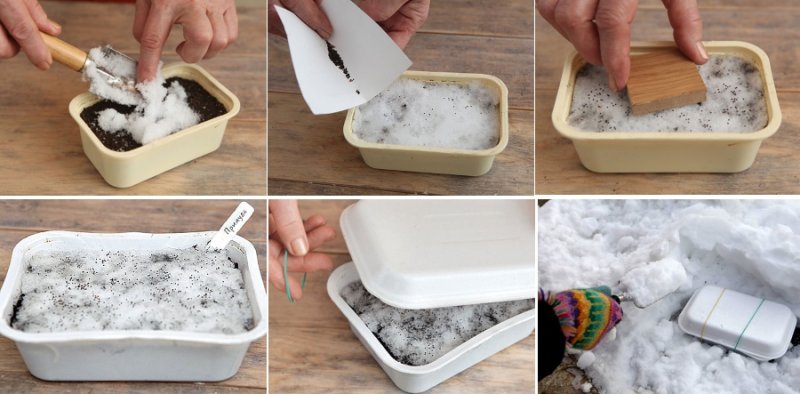
Seeds can be sown in the snow
Spring sowing
- sowing for seedlings is carried out in February-March;
- prefers light soil, a mixture of earth, humus and sand, in a ratio of 1: 1: 1;
- stratification is required, so the container with seeds is removed to the lower shelf of the refrigerator for a month, covering the container with a bag or lid;
- after the hardening procedure, the container with seeds is returned to a warm room, placed on the windowsill and shaded from sunlight until the first shoots appear;
-
as soon as the first 2-3 true leaves appear, the seedlings can be transplanted into pots.
Summer sowing
Seeds of primroses very quickly lose their germination, so immediately after flowering, you need to choose a place in the garden and sow the seeds in the prepared soil. Use as many seeds as possible, during the summer heat the soil dries out quickly and this affects their germination. For the winter, it is better to cover young primrose bushes with spruce branches or foliage.
Please note that not all primrose varieties can be sown from seeds collected from flowers and get the desired result. For example, it is better to sow terry varieties and hybrids from seeds purchased in specialized stores, in this case, you will receive the color and shape declared by the variety. Wild varieties will retain all characteristics unchanged.

Sow seeds in summer immediately after harvest
Winter sowing
In late October-early November, you can organize a small bed with light soil in a shaded area. When the soil freezes slightly, you need to sow primroses in the grooves, covering the seeds with a small layer of potting soil. In early spring, the soil after winter dormancy will be sufficiently saturated with moisture, which will have a beneficial effect on the growth of seeds and the subsequent growth of primrose seedlings.
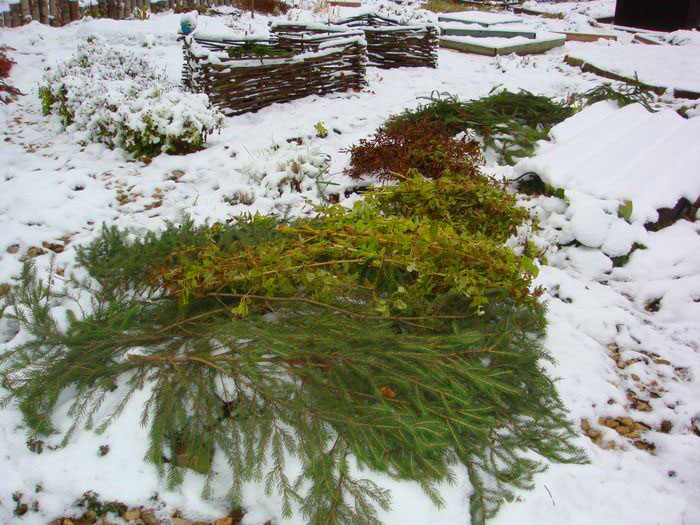
Young bushes require additional shelter
Dividing primrose
The plant grows strongly, forming a continuous carpet over time. Depending on the variety, 3-year-old or 5-year-old bushes are divided. To do this, the bush is dug out and the roots are carefully washed so that the rosettes are clearly distinguishable, then the rhizome is divided into two or three parts. Each piece should contain a recovery bud, a rosette with leaves, and roots. This is done, as a rule, after the plant has faded, at the end of summer.
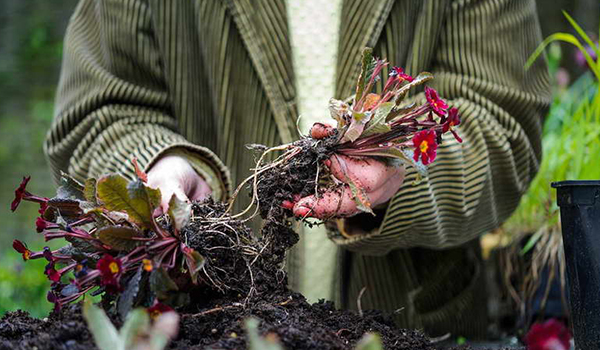
Division of an adult primrose bush
Large bushes can be propagated by cuttings. To do this, the rosette of the plant, after the primrose has faded, is cut into pieces with pieces of root, and dripped in shaded beds into shallow holes (up to 4 cm), with sand and leafy soil, sprinkled with earth on top. As soon as 3-4 real leaves appear, you can transplant it into a shallow pot (up to 10 cm). If you dug right in the garden, then by the next season the sprouted cuttings can already be transplanted to another place.

Primrose cuttings


